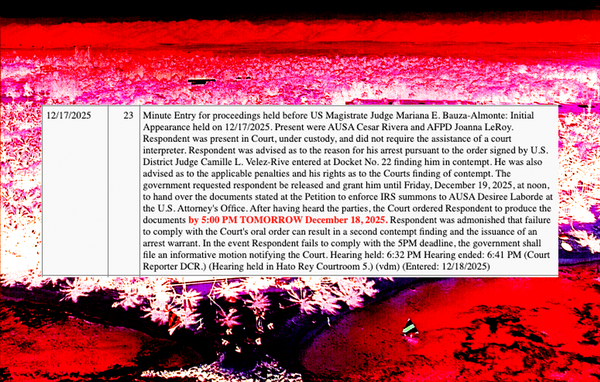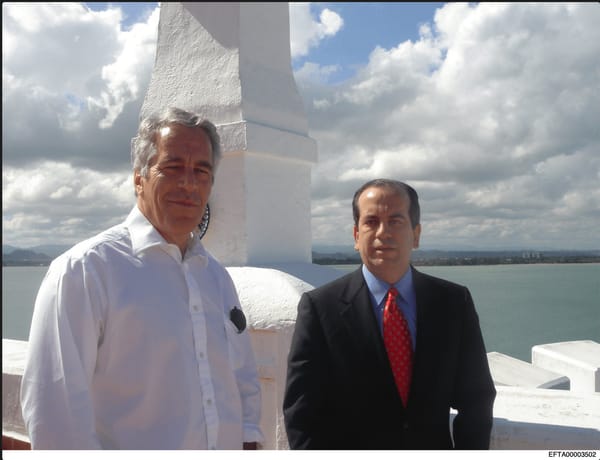Weather Report #3: France Prepares for the World to Burn & New Fortress Energy Annual Finance Report
France published its third national climate adaptation plan, where it prepares by 4°C of warming by 2100. A look at New Fortress Energy's yearly financial report, as well as a recent loan amendment.

Heavy Weather is a 100% reader-funded site. Become a paid subscriber today to make sure articles like this one.
Welcome to the third consecutive Weather Report, a weekly roundup of scooplets and updates that are not big enough for their own post, as well as news and media recommendations. Sorry it’s late this week, but I was on vacation until Tuesday and work things got a little bit ahead of me.
The media recommendations are paywalled, but everything else is free. If you would like to see what articles and books to read, as well as what music to listen to, become a paid subscriber today for as low as $3!
Anyway, here's what's in today's edition:
- France is preparing for a 4°C of warming by 2100, which means that they are preparing for a world on fire.
- A tiny look into New Fortress Energy’s financials through it’s annual 10-K report, more loans to pay for an LNG facility in Mexico, and FERC documents.
- Links to articles about the abduction of Mahmoud Khalil, how unprepared Puerto Rico is for the climate crisis because its government prefers development over everything else, and articles about techno-feudalists and death cults.
- Recommendation for a book about how the FBI ran a tech startup to spy on criminals.
- Two very good songs and one I included because I love a song with a long, ridiculous name.
France Prepares for the World to Burn
On Monday, France published its third national climate adaptation plan. The plan outlines how the country is preparing for a world that has reached 4°C of warming by the end of the century, which would be about 4.5°C and up of global warming, according to Berkeley Earth — a near-apocalyptic scenario for a lot of the planet.
France's plan has five main areas: “protecting people, ensuring resilience of territories and essential services, adapting human activities, protecting natural and cultural heritage, and mobilising national resources,” according to RFI. Specific measures include “creating a national map of exposure to natural risks, maintaining affordable insurance offerings even in high-risk areas, and improving housing to remain comfortable despite rising temperatures.” They plan to invest €1.6 billion for a national heatwave plan, a paltry sum when compared to what they actually need to invest, which is in the multiple billions just to adapt to heat waves through new buildings, housing renovation, and agriculture, according to the Institute for Climate Economics.
A global temperature rise of more than 4°C by 2100 would mean that much of the tropical region along the equator would be “uninhabitable for much of the year,” according to a 2019 Guardian article. “Belts of inhospitable desert” will lie to the north and south of this now-uninhabitable part of the world. These two parts include much of the Caribbean and Latin America, as well as much of Africa and Asia. All coral reefs will have died well before 2100, likely somewhere between 2°C and 4°C. The Amazon rainforest could potentially turn into a savannah. Most rivers, especially in Asia, will flood significantly more. I could go on and on listing all of the bad things that will happen if we ever reach that cataclysmic milestone, but I think you get the picture.
In as much as this affects Puerto Rico, there is no real political will to significantly drop our miniscule-in-the-grand-scheme-of-things emissions, as evidenced by the move towards LNG instead of renewables. Meanwhile, we feel the effects of climate change more and more every day. For example, a bottle of Ibuprofen I keep in my truck melted because I left it parked in the sun. 4°C of warming would mean that I would melt outside (this is hyperbole but not that far from the truth). Since we are part of the U.S., the largest historical contributor to climate change, I expect that to stay the same unless people get really cool about a bunch of stuff really quickly. Given he pulled out of the Paris Climate Accords and his energy plan is "drill, baby, drill," Trump’s climate change plan seems to be actively pushing for the world to burn.
“Adaption is not giving up,” Ecological Transition Minister Agnès Pannier-Runacher emphasized while announcing France's climate plan. This framing, where adaptation is pretty much the only solution that countries are willing to even motion towards, is common among Global North countries. Mitigation, which would include actually reducing GHG emissions into the atmosphere, is left as an afterthought, almost as if there is nothing they could actually do to reduce the causes of global warming. Meanwhile, the third option — suffering — is left unmentioned. However, it will assuredly be the one most of us will experience more and more of as the world gets. This isn’t to say there is no mitigation being done, but solely that there is nowhere near enough to reduce the suffering the world, particularly those in the Global South, will feel.
Former U.S. Science Advisor John Holdren outlined our options as such:
“We basically have three choices: mitigation, adaptation and suffering,” said John Holdren, the president of the American Association for the Advancement of Science and an energy and climate expert at Harvard. “We’re going to do some of each. The question is what the mix is going to be. The more mitigation we do, the less adaptation will be required and the less suffering there will be.”
And from where I am standing, it looks like the richest countries in the world have simply decided that suffering is the way to go for most of us. I plan to write a lot more about this topic, so I hope this works as a nice primer for my thoughts on the matter.
New Fortress Energy 10-K Filing and FERC Documents
I am by no means a finance guru, an accountant, or a person who knows particularly a lot about money but when the first bullet point in your cautionary statement is about “adequately addressing the substantial doubt as to [your] ability to continue as a going concern,” maybe your company is not in the best spot financially. That’s how New Fortress Energy’s (NFE) annual 10-K filing (a yearly financial report companies need to file with the SEC) starts.
Coincidentally, their stock price has fallen by 71.08% over the last year at time of writing.

One of the main risks NFE highlights in the filing is that failure to obtain and maintain permits could impede their operations. The main example the filing cites concerns an ongoing process between them and the Federal Energy Regulatory Commission (FERC) and the U.S. Coast Guard about a micro-fuel handling facility in San Juan. They received a letter from the U.S. Coast Guard about their Puerto Rico operations in September 2024 “alleging that some aspects of our vessel operations may not comply with all applicable requirements.” NFE filed an appeal in October 2024. However, “in December 2024 and February 2025, we submitted an updated Letter of Intent and Waterway Suitability Assessments detailing our alternative operational plans to the USCG and are working collaboratively with the USCG to obtain a new Letter of Recommendation to FERC in support of our operations, which we expect to be imminently forthcoming. In concert with our collaboration with the USCG regarding our new operational plans, we withdrew our appeal on February 14, 2025.”
As I reported last week, Puerto Rico is “perhaps the biggest gas to power opportunity in the world," according to NFE CEO Wes Edens. According to the filing, the company expects their financial strength to improve because of “expected cash flows generated from new gas sale agreements and volume growth in Puerto Rico, Mexico and Brazil.” Building on an announcement last year, the company has “begun to identify strategic partners for one or more of our primary businesses and expect to explore potential strategic partner financing, commercial ventures or assets sales to enhance our liquidity and financial flexibility.”
Something worth noting in the filing is that Genera has more full-time employees than New Fortress Energy. It's not a significant difference but it shows how Genera really is a cash cow for NFE. The company also removed DEI language in the filing that was in 2023's 10-K filing.

That’s about it for the most notable things in the filing, at least to me. You can find the full filing here.
On March 3, 2025, NFE submitted an 8-K filing saying that it amended a credit agreement to be able to take out more loans equal to $425 million “to fund capital expenditures related to the Company’s FLNG2 assets and for other corporate expenses.” FLNG2 is the second “fast LNG” unit at the company’s Altamira, Mexico location. A recent lawsuit alleged FLNG1 was “constructed in a manner that risked [a] catastrophic safety disaster."

As mentioned above, the company is currently undergoing a permit process with FERC. Here's some information from the last few documents uploaded to the two dockets (CP21-496 and CP23-518) related to the San Juan Micro-Fuel Handling Facility:
A letter signed by the Deputy Director of the Military Aviation and Installation Assurance Siting Clearinghouse saying the LNG project located at the San Juan port “may have an impact on military operations conducted in the area.” Specifically, the letter notes the project “may impact U.S. Army military vehicle maintenance facility operations at the Army Reserve Area Maintenance Support Facility 161 location, as well as safety considerations within the Army Terminal Turning Basin.”
Two letters sent by NFEnergía LLC, the company through which NFE imports LNG to Puerto Rico and its subsidiary Genera, to FERC in response to their environmental information request. Quite honestly, a lot of it is very technical data that I am not prepared to dig into without consulting several experts but the one thing that stuck out to me is that, when asked how the LNG project aligns with Puerto Rico’s greenhouse gas emission goals, NFEnergía responds by citing the Public Policy Energy Act of 2019, which “mandates that news fossil fuel generating plants must be capable of operation on natural gas ‘to increase the capacity of the electric power grid and to integrate distributed generation and renewable capacity.’” They say the facility is a “critical component” of emission reduction goals without stating how it actually benefits distributed generation and renewable capacity. LNG is NOT a renewable or clean energy source. The letter goes on to say that the micro-fuel handling facility “would potentially decrease GHG emissions based on Puerto Rico 2019 levels (the baseline for Law 33) by 0.027 percent or 581, 442 tons per year.”

I and many others have argued these renewable and clean energy laws are fallacies, akin to science fiction stories. What's actually needed is a concerted cultural change. Their use of this "renewable energy law" as a legal pathway towards growing the LNG industry in Puerto Rico adds more fuel to that fire. While reductions in GHG emissions are more than welcome, a reduction of 0.03% is nothing compared to what needs to be done (degrowth, installing distributed renewable energy, etc...) options that are actively being thrown by the wayside in favor of these LNG projects.
You can find the letters here:
That's as far as the free post goes. If you want to get the news and media recommendations I have this week, subscribe to Heavy Weather.





